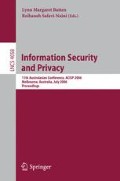Abstract
We propose the notion of plaintext awareness in the two-key setting, called PATK. We also prove that if a public-key encryption scheme is secure in the sense of PATK, then it is also secure in the sense of IK-CCA. Since it looks much easier to prove that a public-key encryption scheme is secure in the sense of PATK than to prove directly that it is secure in the sense of IK-CCA, the notion of PATK is useful to prove the anonymity property of public-key encryption schemes.
We also propose the first generic conversion for the anonymity, that is, we prove that the public-key encryption scheme derived from the Fujisaki-Okamoto conversion scheme, where the basic public-key encryption scheme is secure in the sense of IK-CPA, is secure in the sense of IK-CCA in the random oracle model.
Access this chapter
Tax calculation will be finalised at checkout
Purchases are for personal use only
Preview
Unable to display preview. Download preview PDF.
References
Bellare, M., Rogaway, P.: Optimal Asymmetric Encryption – How to Encrypt with RSA. In: De Santis, A. (ed.) EUROCRYPT 1994. LNCS, vol. 950, pp. 92–111. Springer, Heidelberg (1995)
Fujisaki, E., Okamoto, T., Pointcheval, D., Stern, J.: RSA-OAEP is Secure under the RSA Assumption.In:[14], pp. 260–274
Fujisaki, E., Okamoto, T.: Secure Integration of Asymmetric and Symmetric Encryption Schemes. In: Wiener, M.J. (ed.) CRYPTO 1999. LNCS, vol. 1666, pp. 537–554. Springer, Heidelberg (1999)
Boneh, D., Franklin, M.K.: Identity-Based Encryption from the Weil Pairing. In: [14, pp.223–229
Bellare, M., Desai, A., Pointcheval, D., Rogaway, P.: Relations among Notions of Security for Public-Key Encryption Schemes. In: Krawczyk, H. (ed.) CRYPTO 1998. LNCS, vol. 1462, pp. 26–45. Springer, Heidelberg (1998)
Bellare, M., Palacio, A.: Towards Plaintext-Aware Public-Key Encryption without Random Oracles. In: Lee, P.J. (ed.) ASIACRYPT 2004. LNCS, vol. 3329, pp. 48–62. Springer, Heidelberg (2004)
Phan, D.H., Pointcheval, D.: Chosen-Ciphertext Security without Redundancy. In: Laih, C.-S. (ed.) ASIACRYPT 2003. LNCS, vol. 2894, pp. 1–18. Springer, Heidelberg (2003)
Cui, Y., Kobara, K., Imai, H.: A Generic Conversion with Optimal Redundancy. In: Menezes, A. (ed.) CT-RSA 2005. LNCS, vol. 3376, pp. 104–117. Springer, Heidelberg (2005)
Fujisaki, E.: Plaintext-Simulatability. IEICE Transactions on Fundamentals of Electronics, Communications and Computer Sciences. Special Section on Cryptography and Information Security E89-A, 55–65 (2006)
Bellare, M., Boldyreva, A., Desai, A., Pointcheval, D.: Key-Privacy in Public-Key Encryption. In: Boyd, C. (ed.) ASIACRYPT 2001. LNCS, vol. 2248, pp. 566–582. Springer, Heidelberg (2001) (Full version of this paper) Available via: http://www-cse.ucsd.edu/users/mihir/
Hayashi, R., Okamoto, T., Tanaka, K.: An RSA Family of Trap-door Permutations with a Common Domain and its Applications. In: Bao, F., Deng, R., Zhou, J. (eds.) PKC 2004. LNCS, vol. 2947, pp. 291–304. Springer, Heidelberg (2004)
Hayashi, R., Tanaka, K.: The Sampling Twice Technique for the RSA-based Cryptosystems with Anonymity. In: Vaudenay, S. (ed.) PKC 2005. LNCS, vol. 3386, pp. 216–233. Springer, Heidelberg (2005)
Hayashi, R., Tanaka, K.: PA in the Two-Key Setting and a Generic Conversion for Encryption with Anonymity. Research Report C-224, Dept. of Mathematical and Computing Sciences, Tokyo Institute of Technology (2006), http://www.is.titech.ac.jp/research/research-report/
Kilian, J. (ed.): CRYPTO 2001. LNCS, vol. 2139. Springer, Heidelberg (2001)
Author information
Authors and Affiliations
Editor information
Editors and Affiliations
Rights and permissions
Copyright information
© 2006 Springer-Verlag Berlin Heidelberg
About this paper
Cite this paper
Hayashi, R., Tanaka, K. (2006). PA in the Two-Key Setting and a Generic Conversion for Encryption with Anonymity. In: Batten, L.M., Safavi-Naini, R. (eds) Information Security and Privacy. ACISP 2006. Lecture Notes in Computer Science, vol 4058. Springer, Berlin, Heidelberg. https://doi.org/10.1007/11780656_23
Download citation
DOI: https://doi.org/10.1007/11780656_23
Publisher Name: Springer, Berlin, Heidelberg
Print ISBN: 978-3-540-35458-1
Online ISBN: 978-3-540-35459-8
eBook Packages: Computer ScienceComputer Science (R0)

